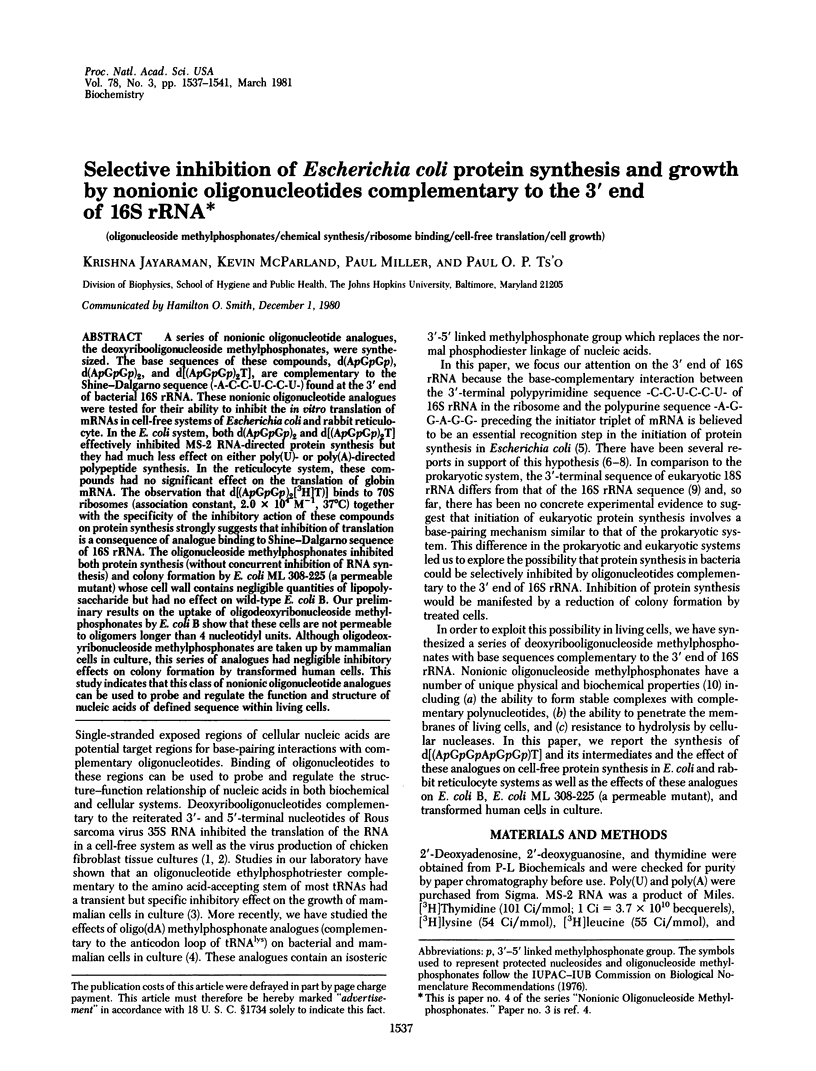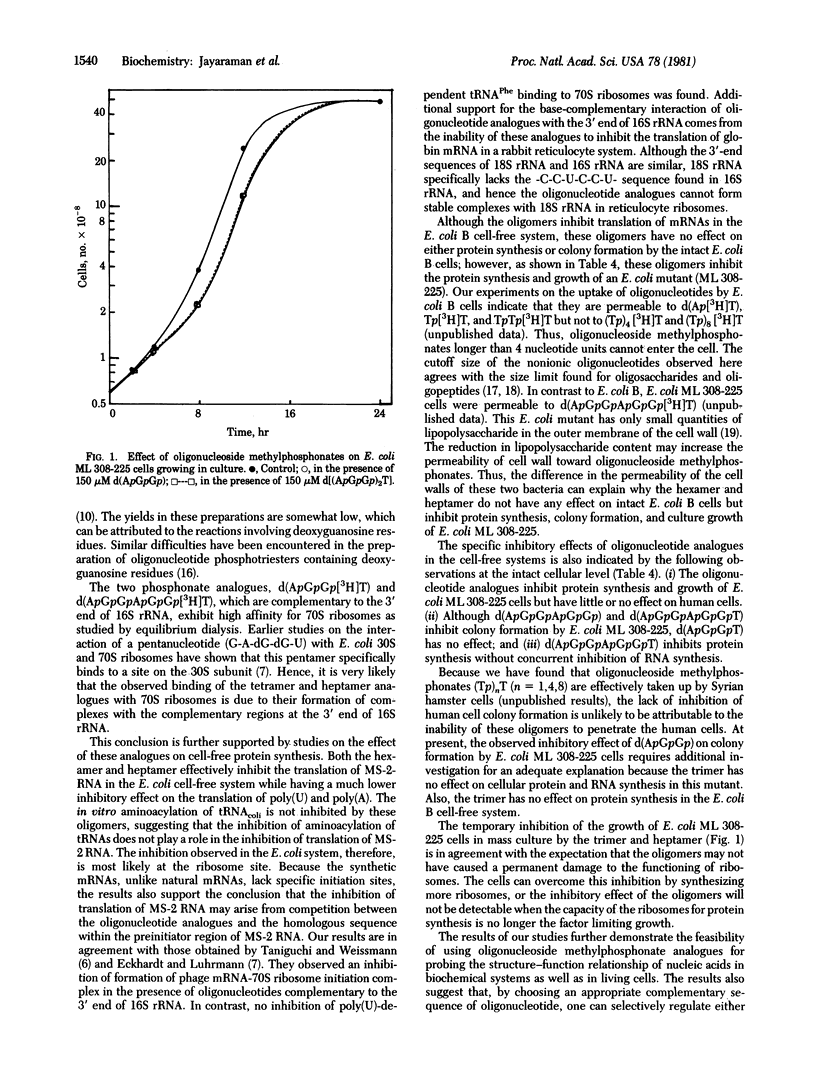Abstract
A series of nonionic oligonucleotide analogues, the deoxyribooligonucleoside methylphosphonates, were synthesized. The base sequences of these compounds, d(ApGpGp), d(ApGpGp)2, and d[(ApGpGp)2T], are complementary to the Shine-Dalgarno sequence (-A-C-C-U-C-C-U-) found at the 3′ end of bacterial 16S rRNA. These nonionic oligonucleotide analogues were tested for their ability to inhibit the in vitro translation of mRNAs in cell-free systems of Escherichia coli and rabbit reticulocyte. In the E. coli system, both d(ApGpGp)2 and d[(ApGpGp)2T] effectively inhibited MS-2 RNA-directed protein synthesis but they had much less effect on either poly(U)- or poly(A)-directed polypeptide synthesis. In the reticulocyte system, these compounds had no significant effect on the translation of globin mRNA. The observation that d[(ApGpGp)2[3H]T)] binds to 70S ribosomes (association constant, 2.0 × 104 M-1, 37°C) together with the specificity of the inhibitory action of these compounds on protein synthesis strongly suggests that inhibition of translation is a consequence of analogue binding to Shine-Dalgarno sequence of 16S rRNA. The oligonucleoside methylphosphonates inhibited both protein synthesis (without concurrent inhibition of RNA synthesis) and colony formation by E. coli ML 308-225 (a permeable mutant) whose cell wall contains negligible quantities of lipopolysaccharide but had no effect on wild-type E. coli B. Our preliminary results on the uptake of oligodeoxyribonucleoside methylphosphonates by E. coli B show that these cells are not permeable to oligomers longer than 4 nucleotidyl units. Although oligodeoxyribonucleoside methylphosphonates are taken up by mammalian cells in culture, this series of analogues had negligible inhibitory effects on colony formation by transformed human cells. This study indicates that this class of nonionic oligonucleotide analogues can be used to probe and regulate the function and structure of nucleic acids of defined sequence within living cells.
Keywords: oligonucleoside methylphosphonates, chemical synthesis, ribosome binding, cell-free translation, cell growth
Full text
PDF




Selected References
These references are in PubMed. This may not be the complete list of references from this article.
- Barrett J. C., Miller P. S., Ts'o P. O. Inhibitory effect of complex formation with oligodeoxyribonucleotide ethyl phosphotriesters on transfer ribonucleic acid aminoacylation. Biochemistry. 1974 Nov 19;13(24):4897–4906. doi: 10.1021/bi00721a004. [DOI] [PubMed] [Google Scholar]
- Bolle A., Epstein R. H., Salser W., Geiduschek E. P. Transcription during bacteriophage T4 development: requirements for late messenger synthesis. J Mol Biol. 1968 Apr 28;33(2):339–362. doi: 10.1016/0022-2836(68)90193-9. [DOI] [PubMed] [Google Scholar]
- DAVIS B. D., MINGIOLI E. S. Mutants of Escherichia coli requiring methionine or vitamin B12. J Bacteriol. 1950 Jul;60(1):17–28. doi: 10.1128/jb.60.1.17-28.1950. [DOI] [PMC free article] [PubMed] [Google Scholar]
- Decad G. M., Nikaido H. Outer membrane of gram-negative bacteria. XII. Molecular-sieving function of cell wall. J Bacteriol. 1976 Oct;128(1):325–336. doi: 10.1128/jb.128.1.325-336.1976. [DOI] [PMC free article] [PubMed] [Google Scholar]
- Hagenbüchle O., Santer M., Steitz J. A., Mans R. J. Conservation of the primary structure at the 3' end of 18S rRNA from eucaryotic cells. Cell. 1978 Mar;13(3):551–563. doi: 10.1016/0092-8674(78)90328-8. [DOI] [PubMed] [Google Scholar]
- Miller P. S., Barrett J. C., Ts'o P. O. Synthesis of oligodeoxyribonucleotide ethyl phosphotriesters and their specific complex formation with transfer ribonucleic acid. Biochemistry. 1974 Nov 19;13(24):4887–4896. doi: 10.1021/bi00721a003. [DOI] [PubMed] [Google Scholar]
- Miller P. S., Braiterman L. T., Ts'o P. O. Effects of a trinucleotide ethyl phosphotriester, Gmp(Et)Gmp(Et)U, on mammalian cells in culture. Biochemistry. 1977 May 3;16(9):1988–1996. doi: 10.1021/bi00628a036. [DOI] [PubMed] [Google Scholar]
- Miller P. S., Cheng D. M., Dreon N., Jayaraman K., Kan L. S., Leutzinger E. E., Pulford S. M., Ts'o P. O. Preparation of a decadeoxyribonucleotide helix for studies by nuclear magnetic resonance. Biochemistry. 1980 Sep 30;19(20):4688–4698. doi: 10.1021/bi00561a023. [DOI] [PubMed] [Google Scholar]
- Miller P. S., Yano J., Yano E., Carroll C., Jayaraman K., Ts'o P. O. Nonionic nucleic acid analogues. Synthesis and characterization of dideoxyribonucleoside methylphosphonates. Biochemistry. 1979 Nov 13;18(23):5134–5143. doi: 10.1021/bi00590a017. [DOI] [PubMed] [Google Scholar]
- Payne J. W., Gilvarg C. Size restriction on peptide utilization in Escherichia coli. J Biol Chem. 1968 Dec 10;243(23):6291–6299. [PubMed] [Google Scholar]
- Shine J., Dalgarno L. Determinant of cistron specificity in bacterial ribosomes. Nature. 1975 Mar 6;254(5495):34–38. doi: 10.1038/254034a0. [DOI] [PubMed] [Google Scholar]
- Steitz J. A., Jakes K. How ribosomes select initiator regions in mRNA: base pair formation between the 3' terminus of 16S rRNA and the mRNA during initiation of protein synthesis in Escherichia coli. Proc Natl Acad Sci U S A. 1975 Dec;72(12):4734–4738. doi: 10.1073/pnas.72.12.4734. [DOI] [PMC free article] [PubMed] [Google Scholar]
- Stephenson M. L., Zamecnik P. C. Inhibition of Rous sarcoma viral RNA translation by a specific oligodeoxyribonucleotide. Proc Natl Acad Sci U S A. 1978 Jan;75(1):285–288. doi: 10.1073/pnas.75.1.285. [DOI] [PMC free article] [PubMed] [Google Scholar]
- Taniguchi T., Weissmann C. Inhibition of Qbeta RNA 70S ribosome initiation complex formation by an oligonucleotide complementary to the 3' terminal region of E. coli 16S ribosomal RNA. Nature. 1978 Oct 26;275(5682):770–772. doi: 10.1038/275770a0. [DOI] [PubMed] [Google Scholar]
- Zamecnik P. C., Stephenson M. L. Inhibition of Rous sarcoma virus replication and cell transformation by a specific oligodeoxynucleotide. Proc Natl Acad Sci U S A. 1978 Jan;75(1):280–284. doi: 10.1073/pnas.75.1.280. [DOI] [PMC free article] [PubMed] [Google Scholar]


